- ▶
- Heaters/Source
- ▶
- Agilent Heaters and SensorsMass Spectrometry, Scientific Supplies & ManufacturingScientific Instrument Services 5973 Source Heater Tamper Resistant Allen Wrench 5973/5975 Quad Sensor 5985 Source Heater Assembly Agilent Interface Heater Assembly 5971 Interface Heater

- ▶
- LiteratureApplication Notes Adsorbent Resins Guide Mass Spec Tips SDS Sheets FAQ MS Calibration Compound Spectra Manuals MS Links/Labs/ Organizations MS Online Tools Flyers on Products/Services Scientific Supplies Catalog About Us NextAdvance Bullet Blender® Homogenizer Protocols Micro-Mesh® Literature Instrumentation Literature Agilent GC/MS Literature SIS News / E-Mail Newsletter NIST MS Database - Update Notifications

- ▶
- Application NotesNote 103: EPA Method 325B, Novel Thermal Desorption Instrument Modification to Improve Sensitivity Note 102: Identification of Contaminants in Powdered Beverages by Direct Extraction Thermal Desorption GC/MS Note 101: Identification of Contaminants in Powdered Foods by Direct Extraction Thermal Desorption GC/MS Note 100: Volatile and Semi-Volatile Profile Comparison of Whole Versus Cracked Versus Dry Homogenized Barley Grains by Direct Thermal Extraction Note 99: Volatile and Semi-Volatile Profile Comparison of Whole vs. Dry Homogenized Wheat, Rye and Barley Grains by Direct Thermal Extraction GC/MS Note 98: Flavor and Aroma Profiles of Truffle Oils by Thermal Desorption GC/MS Note 97: Flavor Profiles of Imported and Domestic Beers by Purge & Trap Thermal Desorption GC/MS Note 96: Reducing Warping in Mass Spectrometer Filaments, with SISAlloy® Yttria/Rhenium Filaments Note 95: Detection of Explosives on Clothing Material by Direct and AirSampling Thermal Desorption GC/MS Note 94: Detection of Nepetalactone in the Nepeta Cataria Plant by Thermal Desorption GC/MS Note 93: Detection of Benzene in Carbonated Beverages with Purge & Trap Thermal Desorption GC/MS Note 92: Yttria Coated Mass Spectrometer Filaments Note 91: AutoProbe DEP Probe Tip Temperatures Note 90: An Automated MS Direct Probe for use in an Open Access Environment Note 89: Quantitation of Organics via a Mass Spectrometer Automated Direct Probe Note 88: Analysis of Silicone Contaminants on Electronic Components by Thermal Desorption GC-MS Note 87: Design and Development of an Automated Direct Probe for a Mass Spectrometer Note 86: Simulation of a Unique Cylindrical Quadrupole Mass Analyzer Using SIMION 7.0. Note 85: Replacing an Electron Multiplier in the Agilent (HP) 5973 MSD Note 84: Vacuum Pump Exhaust Filters - Charcoal Exhaust Traps Note 83: Vacuum Pump Exhaust Filters - Oil Mist Eliminators Note 82: Vacuum Pump Exhaust Filters Note 81: Rapid Bacterial Chemotaxonomy By DirectProbe/MSD Note 80: Design, Development and Testing of a Microprocessor ControlledAutomated Short Path Thermal Desorption Apparatus Note 79: Volatile Organic Compounds From Electron Beam Cured and Partially Electron Beam Cured Packaging Using Automated Short Path Thermal Desorption Note 78: A New Solution to Eliminate MS Down-Time With No-Tool-Changing of Analytical GC Columns Note 77: The Determination of Volatile Organic Compounds in VacuumSystem Components Note 76: Determination of the Sensitivity of a CRIMS System Note 75: An Apparatus for Sampling Volatile Organics From LivePlant Material Using Short Path Thermal Desorption Note 74: Examination of Source Design in Electrospray-TOF Using SIMION 3D Note 73: The Analysis of Perfumes and their Effect on Indoor Air Pollution Note 72: 1998 Version of the NIST/EPA/NIH Mass Spectral Library, NIST98 Note 71: Flavor Profile Determination of Rice Samples Using Shor tPath Thermal Desorption GC Methods Note 70: Application of SIMION 6.0 To a Study of the Finkelstein Ion Source: Part II Note 69: Application of SIMION 6.0 To a Study of the Finkelstein Ion Source: Part 1 Note 68: Use of a PC Plug-In UV-Vis Spectrometer To Monitor the Plasma Conditions In GC-CRIMS Note 67: Using Chemical Reaction Interface Mass Spectrometry (CRIMS) To Monitor Bacterial Transport In In Situ Bioremediation Note 66: Probe Tip Design For the Optimization of Direct Insertion Probe Performance Note 65: Determination of Ethylene by Adsorbent Trapping and Thermal Desorption - Gas Chromatography Note 64: Comparison of Various GC/MS Techniques For the Analysis of Black Pepper (Piper Nigrum) Note 63: Determination of Volatile and Semi-Volatile Organics in Printer Toners Using Thermal Desorption GC Techniques Note 62: Analysis of Polymer Samples Using a Direct Insertion Probe and EI Ionization Note 61: Analysis of Sugars Via a New DEP Probe Tip For Use With theDirect Probe On the HP5973 MSD Note 60: Programmable Temperature Ramping of Samples Analyzed ViaDirect Thermal Extraction GC/MS Note 59: Computer Modeling of a TOF Reflectron With Gridless Reflector Using SIMION 3D Note 58: Direct Probe Analysis and Identification of Multicomponent Pharmaceutical Samples via Electron Impact MS Note 57: Aroma Profiles of Lavandula species Note 56: Mass Spec Maintenance & Cleaning Utilizing Micro-Mesh® Abrasive Sheets Note 55: Seasonal Variation in Flower Volatiles Note 54: Identification of Volatile Organic Compounds in Office Products Note 53: SIMION 3D v6.0 Ion Optics Simulation Software Note 52: Computer Modeling of Ion Optics in Time-of-Flight mass Spectrometry Using SIMION 3D Note 51: Development and Characterization of a New Chemical Reaction Interface for the Detection of Nonradioisotopically Labeled Analytes Using Mass Spectrometry (CRIMS) Note 50: The Analysis of Multiple Component Drug Samples Using a Direct Probe Interfaced to the HP 5973 MSD Note 49: Analysis of Cocaine Utilizing a New Direct Insertion Probe on a Hewlett Packard 5973 MSD Note 48: Demonstration of Sensitivity Levels For the Detection of Caffeine Using a New Direct Probe and Inlet for the HP 5973 MSD Note 47: The Application Of SIMION 6.0 To Problems In Time-of-Flight Mass Spectrometry Note 46: Delayed Extraction and Laser Desorption: Time-lag Focusing and Beyond Note 45: Application of SIMION 6.0 to Filament Design for Mass Spectrometer Ionization Sources Note 44: The Design Of a New Direct Probe Inlet For a Mass Spectrometer Note 43: Volatile Organic Composition In Blueberries Note 42: The Influence of Pump Oil Purity on Roughing Pumps Note 41: Hydrocarbon Production in Pine by Direct Thermal Extraction Note 40: Comparison of Septa by Direct Thermal Extraction Note 39: Comparison of Sensitivity Of Headspace GC, Purge and Trap Thermal Desorption and Direct Thermal Extraction Techniques For Volatile Organics Note 38: A New Micro Cryo-Trap For Trapping Of Volatiles At the Front Of a GC Capillary Column Note 37: Volatile Organic Emissions from Automobile Tires Note 36: Identification Of Volatile Organic Compounds In a New Automobile Note 35: Volatile Organics Composition of Cranberries Note 34: Selection Of Thermal Desorption and Cryo-Trap Parameters In the Analysis Of Teas Note 33: Changes in Volatile Organic Composition in Milk Over Time Note 32: Selection and Use of Adsorbent Resins for Purge and Trap Thermal Desorption Applications Note 31: Volatile Organic Composition in Several Cultivars of Peaches Note 30: Comparison Of Cooking Oils By Direct Thermal Extraction and Purge and Trap GC/MS Note 29: Analysis Of Volatile Organics In Oil Base Paints By Automated Headspace Sampling and GC Cryo-Focusing Note 28: Analysis Of Volatile Organics In Latex Paints By Automated Headspace Sampling and GC Cryo-Focusing Note 27: Analysis of Volatile Organics In Soils By Automated Headspace GC Note 26: Volatile Organics Present in Recycled Air Aboard a Commercial Airliner Note 25: Flavor and Aroma in Natural Bee Honey Note 24: Selection of GC Guard Columns For Use With the GC Cryo-Trap Note 23: Frangrance Qualities in Colognes Note 22: Comparison Of Volatile Compounds In Latex Paints Note 21: Detection and Identification Of Volatile and Semi-Volatile Organics In Synthetic Polymers Used In Food and Pharmaceutical Packaging Note 20: Using Direct Thermal Desorption to Assess the Potential Pool of Styrene and 4-Phenylcyclohexene In Latex-Backed Carpets Note 19: A New Programmable Cryo-Cooling/Heating Trap for the Cryo-Focusing of Volatiles and Semi-Volatiles at the Head of GC Capillary Columns Note 18: Determination of Volatile Organic Compounds In Mushrooms Note 17: Identification of Volatile Organics in Wines Over Time Note 16: Analysis of Indoor Air and Sources of Indoor Air Contamination by Thermal Desorption Note 14: Identification of Volatiles and Semi-Volatiles In Carbonated Colas Note 13: Identification and Quantification of Semi-Volatiles In Soil Using Direct Thermal Desorption Note 12: Identification of the Volatile and Semi-Volatile Organics In Chewing Gums By Direct Thermal Desorption Note 11: Flavor/Fragrance Profiles of Instant and Ground Coffees By Short Path Thermal Desorption Note 10: Quantification of Naphthalene In a Contaminated Pharmaceutical Product By Short Path Thermal Desorption Note 9: Methodologies For the Quantification Of Purge and Trap Thermal Desorption and Direct Thermal Desorption Analyses Note 8: Detection of Volatile Organic Compounds In Liquids Utilizing the Short Path Thermal Desorption System Note 7: Chemical Residue Analysis of Pharmaceuticals Using The Short Path Thermal Desorption System Note 6: Direct Thermal Analysis of Plastic Food Wraps Using the Short Path Thermal Desorption System Note 5: Direct Thermal Analysis Using the Short Path Thermal Desorption System Note 4: Direct Analysis of Spices and Coffee Note 3: Indoor Air Pollution Note 2: Detection of Arson Accelerants Using Dynamic Headspace with Tenax® Cartridges Thermal Desorption and Cryofocusing Note 1: Determination of Off-Odors and Other Volatile Organics In Food Packaging Films By Direct Thermal Analysis-GC-MS Tech No. "A" Note 14: Elimination of "Memory" Peaks in Thermal Desorption Improving Sensitivity in the H.P. 5971 MSD and Other Mass Spectrometers - Part I of II Improving Sensitivity in the H.P. 5971 MSD and Other Mass Spectrometers- Part II of II Adsorbent Resins Guide Development and Field Tests of an Automated Pyrolysis Insert for Gas Chromatography. Hydrocarbon Production in Pine by Direct Thermal Extraction A New Micro Cryo-Trap for the Trapping of Volatiles at the Front of a GC Capillary (019P) - Comparison of Septa by Direct Thermal Extraction Volatile Organic Composition in Blueberry Identification of Volatile Organic Compounds in Office Products Detection and Indentification of Volatiles in Oil Base Paintsby Headspace GC with On Column Cryo-Trapping Evaluation of Septa Using a Direct Thermal Extraction Technique INFLUENCE OF STORAGE ON BLUEBERRY VOLATILES Selection of Thermal Desorption and Cryo-Trap Parameters in the Analysis of Teas Redesign and Performance of a Diffusion Based Solvent Removal Interface for LC/MS The Design of a New Direct Probe Inlet for a Mass Spectrometer Analytes Using Mass Spectrometry (CRIMS) Application of SIMION 6.0 to Filament Design for Mass Spectrometer Ionization Sources A Student Guide for SIMION Modeling Software Application of SIMION 6.0 to Problems in Time-of-flight Mass Spectrometry Comparison of Sensitivity of Headspace GC, Purge and TrapThermal Desorption and Direct Thermal Extraction Techniques forVolatile Organics The Influence of Pump Oil Purity on Roughing Pumps Analysis of Motor Oils Using Thermal Desorption-Gas Chromatography-Mass Spectrometry IDENTIFICATION OF VOLATILE ORGANIC COMPOUNDS IN PAPER PRODUCTS Computer Modeling of Ion Optics in Time-of-Flight mass Spectrometry using SIMION 3D Seasonal Variation in Flower Volatiles Development of and Automated Microprocessor Controlled Gas chromatograph Fraction Collector / Olfactometer Delayed Extraction and Laser Desorption: Time-lag Focusing and Beyond A New Micro Cryo-Trap for the Trapping of Volatiles at the Front of a GC Column Design of a Microprocessor Controlled Short Path Thermal Desorption Autosampler Computer Modeling of Ion Optics in Time-of-Flight Mass Spectrometry Using SIMION 3D Thermal Desorption Instrumentation for Characterization of Odors and Flavors

- ▶
- Note 86: Simulation of a Unique Cylindrical Quadrupole Mass Analyzer Using SIMION 7.0. (This Page)
by Steven M. Colby1 and John D. Prestage2
1Scientific Instrument Services, Inc.; 2NASA Jet Propulsion Laboratory
(Portions Published at PittCon and ASMS 2000)
Introduction
The purpose of this work is to examine the properties of a new cylindrical
quadrupole mass analyzer (CQMA) developed by Dr. John Prestage of JPL1.
The CQMA is unique in that it is constructed from a single cylinder rather
than 4 round or hyperbolic rods. By segmenting the cross-section
of the cylinder into eight or more pieces a quadrupole field can be produced
that is equal to or superior to that generated by the standard rod based
design. We report an analysis of the CQMA using the SIMION 7.0 ion optics
software.
The Cylindrical Quadrupole Mass Analyzer
Advantages to the CQMA include: (1) Greater ease of manufacture. The opening in a cylinder can be manufactured to considerable more accuracy than four independent rods and their associated support mechanism. Electrodes can be established by vapor deposition of a metallic surface on the inside of the cylinder. (2) Reduced weight. The CQMA will require approximately 10 times less material. This is of great importance for portable instruments and for those used on space missions. (3) Reduced power requirements. The electronic capacitance of the CQMA design is at least 2 times lower than that of a typical QMA. In addition the voltage required to operate at the same stability parameters is 10% lower in the CQMA. As a result the CQMA will dissipate less than 1/2 of the power of a traditional instrument. This is also important in portable instruments and also allows the engineer greater flexibility in design parameters such as the choice of r0 and RF frequency. A cross-section of the proposed CQMA design is shown in Figure 1 (taken from Ref. 1.)
Figure 1 CQMA Cross-Section compared to the cross section of a typical
round-rod quadrupole.
SIMION V7.0
SIMION 7.0 is the most recent version of the popular SIMION ion optics simulation program. The new version includes complete windows compatibility. Some of the dozens of new features include: support for windows printer and graphics drivers, printing to the windows clipboard, 50 million point array sizes, and more control over viewing, recording, saving, and rerunning trajectories. The user programming system has a series of new commands to support arrays and data comparison.
SIMION performs simulations using discrete arrays of potentials (finite elements). The user defines electrodes or magnets within a 2 or 3D space and the program calculates the potentials of non-electrode or non-magnet points. Each potential array, or "instance", is placed in an "ion optics bench" along with other arrays that may represent other parts of an instrument. This approach allows each section of a system to be modeled independently. The user can make maximum use of symmetry elements and need not use computer resources to model field free regions. Charged particles can be flown through the ion optics bench and their trajectories calculated. The user programming aspects of the system allow users to define time dependent fields and manipulate the properties of the charged particles.
Experiment
In order to examine the characteristics of the Cylindrical QMA we simulated a CQMA, a standard QMA with circular rods, and a QMA with hyperbolic rods. The mass filters were simulated to a resolution of 0.0134 mm/gird point. These instances were defined as a 2D array and "stretched" in the 3ed dimension on the ion optics bench. A second 3D instance, with resolution 0.0536 mm/grid point, was used to simulate the interface between the mass filter and an entrance/exit lens. This single instance was used in two different positions on the ion optics work bench so it could serve at both the entrance and exit. The 3D instance included a lens element and a short section of the quadrupole so that the transition between the two parts would be modeled correctly.
Results
We first examined the fields produced by each type of filter using SIMION's contour feature. This utility plots equal-potential contours within a cross-section of an instance. Results are shown in Figure 2. Figure 2a, 2b, and 2c show each filter independently. The contours represent ground and +/- 90, 50, and 10 percent of the voltage on the electrodes. Figure 3 illustrates an overlay of the QMA, CQMA, and ideal hyperbolic electrodes. In the center region the contours overlap within the precision of the simulation. (Figure 3b is an expansion of the center region.) From this comparison we expect that the CQMA will have filtering properties that are similar to standard devices. Their performance will be most dependent on the precision of manufacture and assembly. As previously pointed out the CQMA may have advantages in this area.
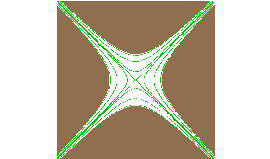
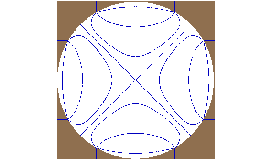
Figure 2. Equal-potential contours. A) Hyperbolic rods, B) Round Rods, C) CQMA
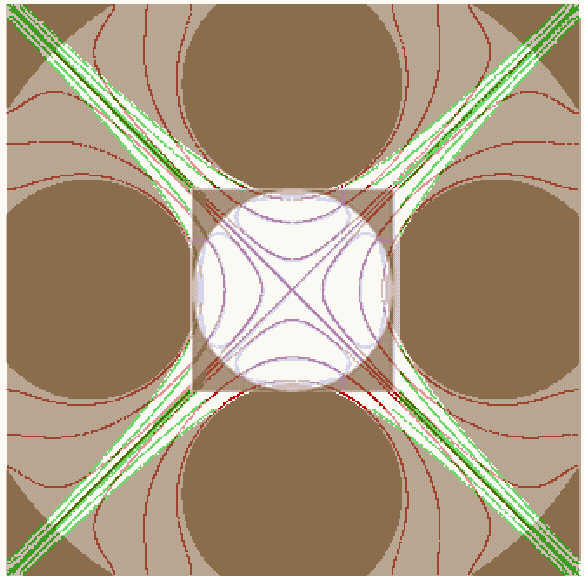
Figure 3. Overlay of the contours shown in Figure 2.
Our next step was a Monto-Carlo simulation of ions passing through the filter. This simulation included the entrance and exit structures. Using SIMION's user programming features we introduced ions with random initial positions, trajectories, and energies. The widths of the initial distributions were wide enough to test the limits of the mass filters. Five thousand ions each were flown through the CQMA and standard (round rod) QMA. At the tuned mass both filters passed 100% of the ions. At one unit away from the tuned mass the QMA passed 45% of the ions and the CQMA passed xx%. (Note that this simulation does not include many of the optic elements that would normally be found in a functional system and that our distributions were intentionally selected so as to test the limits of the filters. In an actual implementation better filtering would, of course, be possible.)
The slightly different filtering efficiency of the CQMA may be attributable to the fields in the transition between the mass filter and the entrance and exit apertures. The enclosed structure of the CQMA could reduce the influence of the grounded aperture. The ideal quadrupole fields would therefor be disrupted over a shorter distance near the interface.
In order to test this hypothesis we examined the field contours at the very entrance of the filters. The results are shown in Figure 4. This figure is an overlay of the ideal hyperbolic fields as measured in the center of the filter (from Figure 2a) and the fields as measured at the entrance of the filters. The colors of one set of contour lines have been enhanced in order to highlight their differences. As shown the QCMA is 15 to 20% closer to the ideal hyperbolic fields.
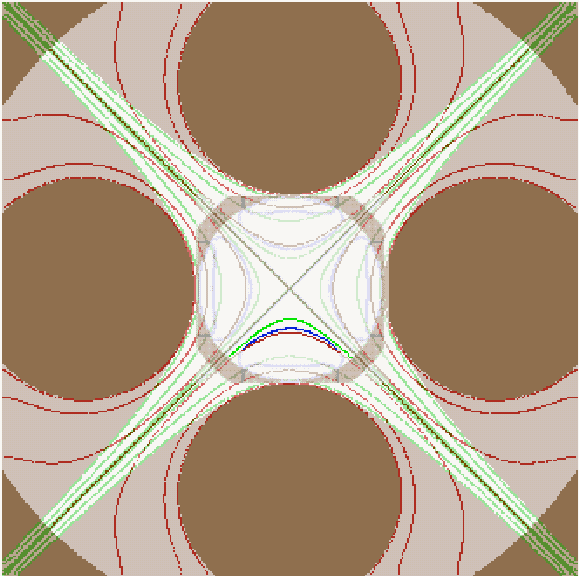
Figure 4. Overlay of the contours near the ends of the filter.
In our next experiment we examined modifications to the transition region between the entrance and exit lenses and the quadrupole filter. The first of these is the use of a split lens element and the second is a variation in the shape of the mass filter electrodes.
Split Entrance/Exit Lens
We wished to see if the electric fields in the in the transition region between the flat plates of the optics and the mass filter could be improved to be more like the ideal hyperbolic field. We split the entrance lens in the same angular spacing as the CQMA. This is shown in Figure 5. Each segment of the split lens was varied with the same potentials as the corresponding regions of the CQMA. The filter was also extended up to the lens. The resulting 3D contours are shown in Figures 6 and 7. Figure 6a and 6b illustrate the fields in with and without the split lens respectively. To simplify the image only the potentials at 90% of +V and - V are drawn and a cross-section of the region shown. In comparison Figure 4c shows the same potential contours at the center of the mass filter. It is clear that the split lens generates a much more ideal field at the transition region. Figure 7 shows this in an overlay of a thin cross-section of the fields from 6a and 6b.
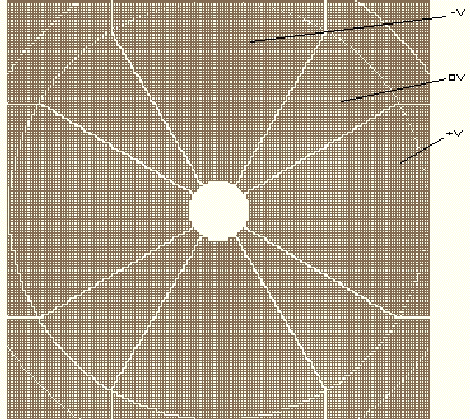
Figure 5. Split Enterance Lens
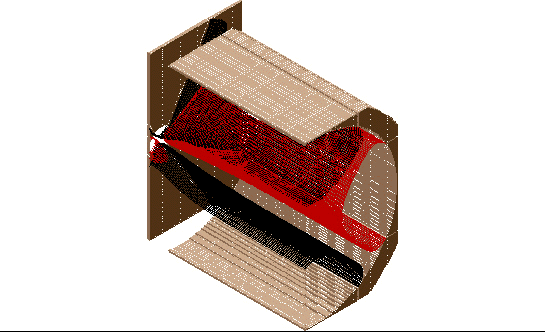
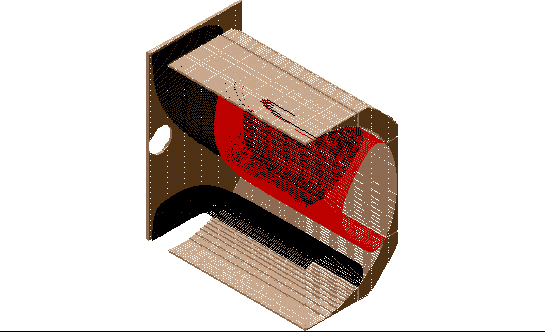
Figure 6. Equal-potential surfaces. A) With and B) Without Split
lens.
Figure 7. Overlay of surfaces.
We examined the trajectories of ions through the system that included split lens. It was found that the single, grounded, lens had been of considerable use in focusing ions toward the center of the mass filter. Additional focusing optics were required when the split lens was used. We were, therefore, not able to perform Monte-Carlo simulations that could be directly compared with our simple model.
Variation of the Mass Filter Shape
A unique aspect of the CQMA is that the spacing and relative ratio of the electrodes may be varied to produce a beneficial effect. This may be an important advantage to this filter design. We examined the consequences of changing the relative ratio of the -V, +V, and 0V electrodes near the entrance and exit lenses. Examples are shown in Figure 8. The ratios of the electrodes were changed in a continuous linear fashion such that at 4 mm the ratios had changed from 60 degrees/30 degrees to 75 degrees/15 degrees. At the lens the grounded region was eliminated entirely and each +/-V segment covered a full 90 degrees. The lens itself was held at 0V. Note that a variation in the shape of the electrodes such as this would not be practical in the standard rod design.
Figure 8. Changing electrode ratios.
The effects of this new design are shown in Figure 9. This figure shows the same contours as are used in Figure 6.
Figure 9. Contours with new ratios.
Our next step was a Monto-Carlo simulation of ions passing through the filter. This simulation included the entrance and exit structures. Using SIMION's user programming features we introduced ions with random initial positions, trajectories, and energies. The widths of the initial distributions were wide enough to test the limits of the mass filters. Five thousand ions each were flown through the new geometry and the standard CQMA. At the tuned mass the standard CQMA passed ~93% of the ions. While one mass unit away it passed 82%. Under similar conditions the new geometry passed 75% and 31% respectively. (Note that this simulation does not include many of the optic elements that would normally be found in a functional system and that our distributions were intentionally selected so as to test the limits of the filters. In an actual implementation better filtering would, of course, be possible.)
Conclusions
We have shown that the Cylindrical Quadrupole Mass Filter is a suitable replacement for the standard four-rod design. In addition to possible advantages in design and manufacture the CQMA is expected to require less than 10% of the mass and 50% of the power of a conventional system. These features are critical for space or environmental applications wherein the device must be moved and have its own power source.
We have also shown that the CQMA may also have advantages in filtering efficiency. A unique aspect of the design is that the ratio of the relative electrode sizes could be changed as a function of position without changing the diameter of the cylinder. This may offer additional opportunities to improve the quality of the fields at the beginning and end of the filter.
For information regarding this technology contact Jim Smart at the Caltech Office of Technology Transfer (626)395-3058.
References:
1: John D. Prestage, NASA Tech Brief Vol. 23, No. 5.
2: Steven M. Colby and John D. Prestage, PittCon 2000, Abstract #1933.
3: Steven M. Colby and John D. Prestage, PittCon 2000, Abstract #P296.

